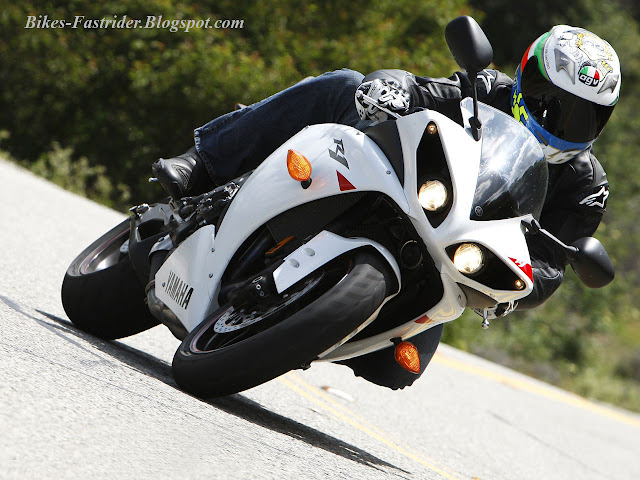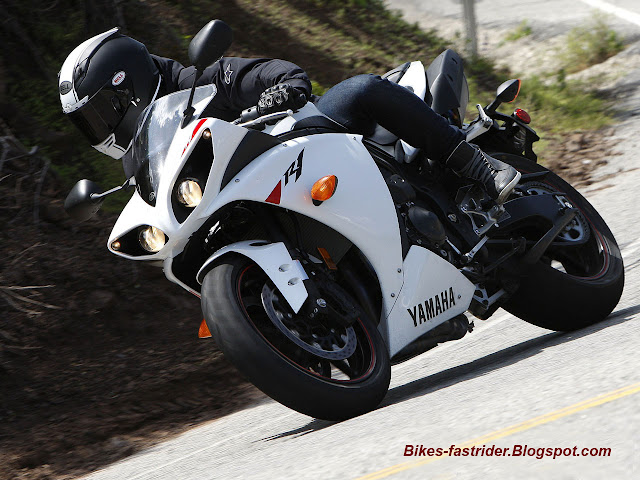Live to Ride and Ride to live Free.
Mostly unchanged for 2010, the new-in-’09 Yamaha R1 came into our shootout much better prepared and with a rock-solid base set-up this time around. The boys in blue found that our handling problems last year were due in part to an unusual issue within the fork. And with that remedied, the Yamaha produced a much more consistent performance, the same one we were quite fond of at the 2009 Yamaha YZF-R1 First Ride in Australia last year.
Nearly all those who threw a leg over the R1 found its suspension much more compliant than the previous bike. It was balanced, composed and worked in unison throughout the stroke. However, with a fork that would dive quite quickly under braking and a rear shock that transferred a great deal of weight led to mixed feelings about the Yamaha’s suspension. I can tell you without a doubt that the suspension is virtually perfect for street riding, but as a whole the R1 is still on the soft side when subjected to pure racetrack abuse.
“Like the BMW, the Yamaha forks were pretty solid until you put that extra load on them during some of the faster laps,” explains fast club-level racer Frankie Garcia. “The front end would push ever so slightly at a fast pace. Also, when braking into a corner hard the front end would dive a lot.”
Sorensen adds: “Again the rear was set up much more balanced this year. The bike had good attitude as you set it into the corner, tracking bumps well on the gas. But I think overall, I would like a more ridged set-up front and rear to give more feedback – it just transfers a great deal of weight no matter what one does when pushing hard.
Also receiving mixed views was the crossplane crankshaft engine. The smooth power delivery allows easy, graceful drives off the corners, no matter one’s skill level. Not to mention a unique sound that nearly everyone found soothing and easy on the ears. As for the mixed side: There’s a lack of top end. Other than the KTM, the R1 falls off the most up top when it’s being pushed hard. Even so, many rated the bike as being extremely easy to ride and it was mid-pack this year in terms of outright quickest lap times, a big leap forward from last year.
“One word: La-Z-Boy,” Hensley comments “That’s how this thing feels. Like a big, comfortable La-Z-Boy. Believe it or not, that’s a compliment. This is a bike that you know you could ride the hell out of if you chose to and it’s not going to bite you in the ass…It has really friendly power and I like the sound.”
Hutch agrees with Hensley. “I get along well with the R1. It is less intimidating than the GSX-R, Ninja or the BMW and that allows you to focus on riding a bit more and not stressing out so much about getting high-sided.”
Fast-guy Earnest’s impressions somewhat reflected those of the others as well, though he noticed some added seat-of-the-pants power compared to the ’09 bike. “The engine seems faster than last year’s test bike,” he says. “It has the easiest power delivery of the bunch, feeling more like a Twin than an Inline Four. But it just seems to take too long to rev out.”
This slow-building power showed up right away when we got the R1 up on Lee’s Cycle’s dyno, the bike turning the rear wheel to the tune of 150.89 hp and 76.55 lb-ft of torque. While nothing to scoff at, in this field it’s playing at the back of the pack. The performance numbers at El Toro were matching as the R1’s 10.22 ET @ 138.4 mph in the quarter-mile was at the rear of the group.
Some of this comes down to the fact that it’s tough to get a good launch thanks to its somewhat feeble clutch. The light clutch action is nice on the street and track but when it comes to hard drag strip launches it’s very difficult to keep it behaving correctly and as a result it posted the lowest elapsed time and speed through the trap. It’s also worth noting that by the end of our performance testing the clutch cable was adjusted all the way out, a telling sign that the clutch plates were on their final leg.
However back on the track, the Yamaha transmission and clutch scored right in the middle of the pack by our test riders; it held up to the day’s abuse without issue. A couple riders noted a slightly “mushy” feeling, while most of the others were impressed with the ease of lever operation and didn’t have the slightest issue.
“The Yamaha shifts quick and smooth, though I missed a downshift on corner entry, but that could have been my fault,” says Earnest. Sorensen’s comments were along the same line, the champ saying that the “Yamaha used to have a chunkier tranny, but all that is gone. It’s smooth, short-throw shifts; I had no complaints.”
But the brakes were an area where the R1 continued to struggle. While feel and feedback were better than last year, with a less wooden feel to them, the initial bite was lackluster and they had a tendency to fade over the course of long runs. As such, most riders found them to be merely average. And in this cutthroat group, average just doesn’t make the grade. The word “soft” came up often in the rider’s opinions. And out at El Toro its 133-foot braking distance from 60 mph was at the back of this tightly-packed bunch. Though one will note that six of the eight bikes were within 10 feet of each other and it was only 15 feet from first to last.
“Not bad brakes but a bit soft in the lever,” says Neuer of the R1. Hensley’s comments were nearly the exact same thing, adding that “the brakes are soft, kind of like everything else on the Yamaha. As a whole the bike just feels very relaxed.”
A look at the data shows middle-of-the-road acceleration numbers exiting Turn 6 at 0.66g, though coming out of the final, slower corner it struggled, with a best of 0.63g, putting it third from the back. Though despite the “soft” feeling brakes, it still produced some of the best braking g-force numbers going into Turn 14 at -1.21g.
But where the Yamaha shined was its class-leading maximum grip figure in Turn 2, sticking to the pavement at the tune of 1.2g as a result of the balanced set-up and solid chassis. Though it didn’t produce the highest grip in the final set of corners, the 1.3g it was capable of in Turn 15 put it at the pointy end of the field. It may not have been the easiest to get settled into a turn, but once on its side the chassis was a thing a beauty.
“As soon as both wheels were planted it was all good,” Earnest says. “It may have backed in a bit entering the corner, but once leaned over that R1 was very planted.”
It was also respectable down the front straight, reaching a top speed of 150.7 mph, which was right on par with the Kawasaki and the Aprilia, while ahead of the KTM and the Suzuki. All told the Yamaha ticked off a 1:57.55 as a best Superpole lap, landing it just outside mid-pack, though much closer to the competition than last year.
Even after a couple years in production, it’s still impossible not to talk about the sound that the Yamaha makes. More like a V-Twin and a V-Four mix than an Inline Four, there’s no question the R1 makes music to any motorcycle junkie’s ears.
How can you not love the way the Yamaha sounds? “It’s not like anything on this planet and every time it made a pass down the front straight it gave me tingles down my spine. I like the sound when hearing it from the sidelines as well as from the saddle. It’s almost soothing, makes me feel relaxed but fast when riding.”
As a purely track-based test, the stock Yamaha cannot compete for top honors. Its lower horsepower numbers, high curb weight and soft suspension held it back from running at the front both on the racetrack and at the airstrip during performance testing. And when it comes to an overall ranking, that’s the majority of how the track test is evaluated. But that doesn’t mean there isn’t something special about the Yamaha. With its iconic R1 styling and the awesome sound of that unorthodox engine, there’s no question the Tuning Fork superbike exudes character from every last turn of the crossplane crank. We’ve liked this bike immensely since first riding it more than a year ago and nothing about that has changed. It’s just that in the company of this test on the racetrack the points happen to put it at the back of the class. As for on the street, well that’s a totally different story…
Labels: fast-bikes, fazer, speed., track-racing, yamaha
0 Comments:
Subscribe to:
Post Comments (Atom)
















